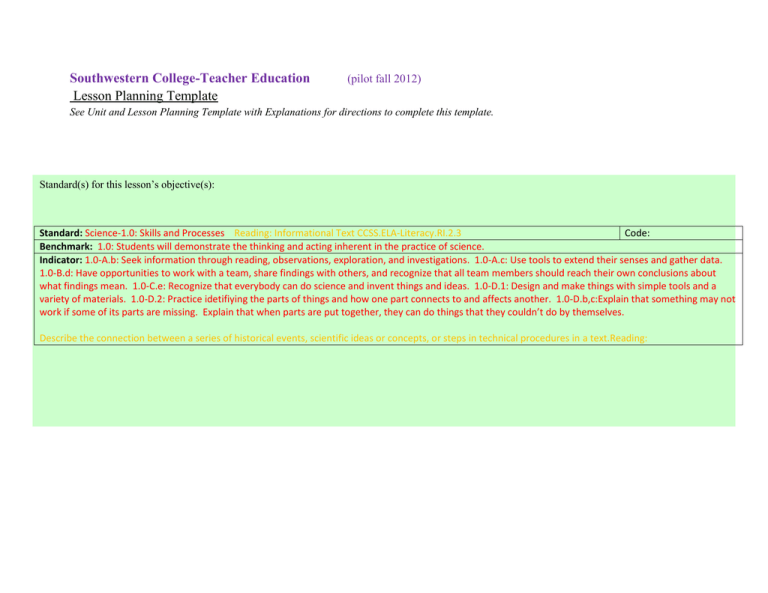File - Megan Chigua
advertisement

Southwestern College-Teacher Education Lesson Planning Template (pilot fall 2012) See Unit and Lesson Planning Template with Explanations for directions to complete this template. Standard(s) for this lesson’s objective(s): Standard: Science-1.0: Skills and Processes Reading: Informational Text CCSS.ELA-Literacy.RI.2.3 Code: Benchmark: 1.0: Students will demonstrate the thinking and acting inherent in the practice of science. Indicator: 1.0-A.b: Seek information through reading, observations, exploration, and investigations. 1.0-A.c: Use tools to extend their senses and gather data. 1.0-B.d: Have opportunities to work with a team, share findings with others, and recognize that all team members should reach their own conclusions about what findings mean. 1.0-C.e: Recognize that everybody can do science and invent things and ideas. 1.0-D.1: Design and make things with simple tools and a variety of materials. 1.0-D.2: Practice idetifiying the parts of things and how one part connects to and affects another. 1.0-D.b,c:Explain that something may not work if some of its parts are missing. Explain that when parts are put together, they can do things that they couldn’t do by themselves. Describe the connection between a series of historical events, scientific ideas or concepts, or steps in technical procedures in a text.Reading: Lesson Plan Template (refer to Unit and Lesson Plan guidelines with explanations for components of each section of template) Name- Megan E. Chigua Subject area- Science Course- EDUC 437 Date- 10/09/13 Grade level- 2nd Time allotted for each component. 55 min Lesson Title: Life Cycle of a Plant Objective(s): Standard 1.0: Students will demonstrate the thinking and acting inherent in the practice of science. Assessment: Students will receive informal observation during instruction and formal observation during practice. Homework from day 2 will be graded and placed in science binder. Meeting the needs of various learners/Accommodations: Parent volunteers will be utilized for practice project as well as teacher/group dynamics. This is a hands on activity so ELL teacher is not needed. Instructional Plan- 1.) Re-cap life cycle and factors 2.) Read “How Does My Garden Grow” 3.) Complete flash cards 4.) Begin plating projects Opening: Re-cap life cycle and factors of plant growth from days 1 and 2. Read “How Does My Garden Grow” and discuss book. 13 min Instruction: After reading and discussing, we (whole group discussion/demonstration) will complete “Plant Life Cycle” flashcard worksheet. 15 min Practice: Using flashcards, students will begin planting project. Give students pots, soil options, and have them pick a growth location in the classroom. While passing these items out explain what is going to happen (they will plant and chart their own plants). Students need to reference their science binders to decide which soil and what light yields the best plant growth. Students need to check off their flash card steps in their binder so that they know which step they are on. (This project takes 1-2 parent volunteer(s).) Closing: Re-cap the plant project and its purpose and give a list of the seeds available for them to grow. The following seeds are available: daisy, sunflower, cilantro, rosemary, parsley, and wildflower mix. Students need to decide which seed they want to grow for homework as they have to choose on day 4. Have students leave their science binder so that the teacher can ensure their notes and worksheets are complete as they will use this information to grow their plant. After Assessment: Gather feedback from parent volunteers on how the unit is going and the students engagement. If needed tweak expectations and time constraints. 20 min 7 mins




